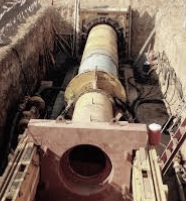Pipe ramming is also called as pipe jacking.
Table of Contents
What Is Pipe Ramming?
Pipe ramming is a trenchless method for installing steel pipes and casings. It is commonly used for distances of 30 meters or more and pipes with diameters of over 500 mm.

It is useful for installations under railway lines and roads where other trenchless methods may cause subsidence or heaving. The majority of installations are horizontal, but it can also be used for vertical installations.
The main difference between pipe ramming and pipe jacking is that pipe ramming uses percussion and does not have a navigation system, while pipe jacking uses hydraulic jacks and has an active navigation system.
Pipe ramming is suitable for shorter distances and applications that do not require tight directional control, such as cable installations.
The method uses pneumatic percussive blows to push the pipe through the ground. The leading edge of the pipe is usually open, and only closed for smaller pipe installations. The shape of the pipe allows for a small overcut to reduce friction and improve load conditions on the pipe. It also directs the soil into the pipe interior instead of compacting it outside the pipe. These objectives are typically achieved by attaching a soil-cutting shoe or special bands to the pipe.
Lubrication is used to further reduce friction, and different types of bentonite and/or polymers can be used for this purpose. Spoil can be removed from the pipe after the entire pipe is in place for shorter installations. For longer installations, if the pipe containing the spoil becomes too heavy, the ramming can be interrupted and the pipe cleaned. Spoil can be removed using an auger, compressed air, or water jetting.
Research on instrumented pipe ramming installations has led to the development of models for estimating the feasibility of pipe ramming installations. These models take into account static soil resistance and dynamic parameters such as drivability of rammed pipes.
Process Of Pipe Ramming
Pipe ramming is a trenchless method for installing pipes underground that utilizes a specialized equipment and steel pipes. The ramming equipment is positioned in the insertion pit, or in the side of an embankment or slope, and aligned in the direction of the pipe installation. Guide rails are recommended to maintain the grade and to ensure proper alignment.
There are two types of pipes used in pipe ramming: open-end and closed-end pipes. Open-end pipes are favored as they require less force to drive, reducing the risk of heaving or deflection. Closed-end pipes are used when installing open-end pipes could disturb the stability of nearby utility lines or cause surface subsidence. The first pipe segment is fitted with a special welded band that protects the pipe and provides a slight overcut to reduce friction between the soil and the pipe.
The ramming tool uses repetitive percussive blows to drive the pipe into the soil. The process can be done for an entire length of pipe or for shorter lengths, depending on the availability of space and the ground conditions. Compressed air is used to power the pneumatic hammer that rams the open-end casing into the soil until it reaches the exit point. To lengthen the drive, additional pipe lengths can be welded onto the casing. Periodic cleaning is required to remove soil accumulation and drag, which can be done using compressed air or water jets for smaller diameter pipes and by augers for larger diameter pipes.
Pipe ramming is faster than the pipe jacking method, but it lacks the precision of sonde-guided drilling or microtunneling. It’s speed is similar to auger boring or horizontal directional drilling. It is recommended to use steel casing pipe when using the trenchless method of pipe ramming. It is a cost-effective and efficient method for installing pipes underground without causing disruption to the surface.
Advantages
Pipe ramming is an efficient and cost-effective solution for installing underground pipes, particularly in suitable ground conditions. With this method, the width and depth of the necessary excavation pits are greatly reduced, resulting in a significant reduction in installation time. In fact, pipe ramming can install 40 to 60 feet sections in just half an hour, compared to the half-day time frame required by horizontal auger boring. This method also allows for the installation of larger pipes over shorter distances, as well as in shallow depth situations. Additionally, pipe ramming can be combined with directional drilling to free a stuck product pipe during pullback. The precision of pipe ramming is also noteworthy, with accuracy typically better than ± 1% in both vertical and horizontal dimensions of the bore.
FAQS
What is pipe jacking?
Pipe jacking is a trenchless method of installing underground pipes, where pre-fabricated pipe sections are pushed or pulled through the ground using a hydraulic jacking system.
What are the benefits of using pipe jacking?
Pipe jacking offers several benefits such as cost-effectiveness, minimal disruption to the surrounding environment, efficient and larger diameter pipes installation than traditional trenching.
